A Shopping Guide to Eco-Friendly Products
From appliances to home decorating, we tell you what to buy and where to find it.


Browse the aisles of a supermarket, department store or home-improvement center for eco-friendly products, and you might conclude that the greening of America had stalled at the starting gate. Even Home Depot, which introduced its Eco Options program last summer to identify products that meet its criteria for environmental friendliness, had few Eco Options signs at stores we visited, and stickering of individual products was nearly nonexistent.
Buying with the environment in mind will get easier as manufacturers adopt greener practices and offer greener products. But for now, save gas and aggravation by shopping on the Internet. We've included Web sites for the products recommended in this story, or go to www.ecobusinesslinks.com. A number of large cities also have green home centers, such as Amicus, near Washington, D.C.; Natural Built Home, in Minneapolis; and the Green Home Center, in San Francisco.
APPLIANCES
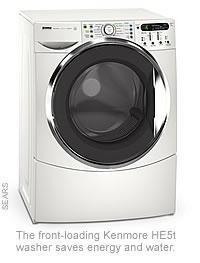
Problem: The average home annually creates twice the greenhouse emissions of the average car. The biggest culprits? Furnaces and air conditioners, which account for about half of the typical family's energy costs. Other appliances are responsible for another third of utility bills.

Sign up for Kiplinger’s Free E-Newsletters
Profit and prosper with the best of expert advice on investing, taxes, retirement, personal finance and more - straight to your e-mail.
Profit and prosper with the best of expert advice - straight to your e-mail.
Better choices: Energy Star appliances generally use up to 50% less energy than products that meet only federal minimum standards (standards for water heaters are in development). Look for the yellow Energy Star label in stores, or check www.energystar.gov. For example, Energy StarPrated clothes washers and dishwashers use at least 30% less energy than standard models, and they save water, too. For a large-capacity, high-efficiency front-loading washer, check out the Kenmore HE5t (Current Prices) and the Bosch Nexxt 500 Series (Current Prices). In the ultra-efficient-dishwasher category, the Bosch Evolution 800 Series, introduced this summer, greatly exceeds the federal minimum standard for energy efficiency (it uses 60% less), but it's pricey (Current Prices).
The U.S. Environmental Protection Agency's new WaterSense program has begun certifying high-efficiency toilets that use only 1.3 gallons of water or less per flush. Replace a toilet made between 1980 and 1994 and you could save as much as $90 a year. We recommend the Kohler Cimarron EcoSmart toilet (Current Prices) or the Toto Aquia (Current Prices). Both are dual-flush models that let you choose a lower or higher water flow as needed.
Trade-off: Some appliances cost more up front, but you'll recoup the extra cost in energy savings within five years.
Comments: Deciding what to replace first depends on your region's climate and your lifestyle. For example, if you live in a harsh, northern climate and your natural-gas furnace is 15 years old, you'll see big savings from a new model that achieves at least 90% efficiency, such as the Carrier Infinity 96. Such high-efficiency furnaces typically cost from $1,300 to $1,700, depending on size, or up to $4,000 installed (because of the need to upgrade vents and ductwork). You'll pay $1,000 more than you would for an 80%-efficient model, but you'll save about $32 per $100 of annual fuel costs when you replace, say, a 20-year-old, 65%-efficient model with a 95%-efficient one.
Another easy target is the beer fridge in the basement. Energy Star models, such as the Frigidaire FRT21HS6D ($599), use 40% less energy than conventional ones sold in 2001. Replacing a ten-year-old model with a new, high-efficiency fridge saves an average of $100 annually in energy costs.
[page break]
BUILDING PRODUCTS
Problem: As the world's appetite for wood and agricultural land grows, we're consuming forests faster than they can grow or than we can replace them. Deforestation (of about 27,000 square miles annually) and poor forestry management cause erosion, diminish air and water quality, and leave fewer trees to absorb carbon dioxide from the atmosphere.
Better choices: The gold standard for responsible forest management is certification by the Forest Stewardship Council (www.fsc.org). Ask your builder or contractor to use lumber with the FSC stamp (a checkmark and a tree). Or consider cellular PVC lumber, made from recycled plastic. For decking and other low-load uses (such as fences and railings), try composite lumber, such as Trex (www.trex.com). It's made from waste wood and recycled plastic, and it doesn't have to be painted or sealed.
Trade-offs: Because of supply-chain issues, FSC-certified lumber may be hard to find, and it will cost up to 15% more than a noncertified equivalent. Composite decking costs about the same as high-end redwood and cedar. Although most composite lumber is "UV stabilized" to stand up to sunlight, colors will fade a bit over time. Plus, critics wonder how this hybrid material will be recycled.
Comments: Three useful guides are www.toolbase.org, which is sponsored by the U.S. Department of Housing and Urban Development's PATH program (Partnership for Advancing Technology in Housing), www.builditgreen.org (click on "green resources" and "fact sheets") and the GreenSpec Directory (www.buildinggreen.com; $89).
LAWN CARE
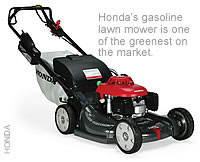
Problem: The EPA estimates that a gasoline-powered mower can produce as much pollution in an hour as 11 cars and that a riding mower can spew as much pollution as 34 cars. Plus, mowers often leak fuel. Pesticides that are used to fend off weeds may be carcinogenic, cause reproductive and developmental problems, and contaminate groundwater.
Better choices: Electric mowers use less energy than gas models, but they're impractical for large yards. The EPA has proposed new emissions standards that will take effect in 2011 or 2012; the final rules are likely to mirror California's current standards. In its ratings for lawn mowers this past spring, Consumers Union (www.greenerchoices.org) rated the John Deere X304 ($3,500) best for gas-powered riding mowers, and the Honda HRX217HXA ($800) topped the list of self-propelled mowers.
To keep your lawn weed-free, consider an Integrated Pest Management approach. IPM advocates using the solution that poses the least risk to health and the environment first. (For more on IPM, visit www.epa.gov/pesticides/controlling/garden.htm. At EPA's site, you can also read about biopesticides.) If you use a lawn service, find one that practices IPM. For example, Green Shield Certified (www.greenshieldcertified.org) recommends professionals who agree to avoid the use of chemicals unless absolutely necessary.
Trade-off: Sacrifice chemicals and you'll sacrifice lawn nirvana, too. If you decide to approach your lawn with a chemicals-as-a-last-resort mind-set, you could end up with a healthier lawn in the long run, but you'll need the patience to revisit problems (and pull weeds).
Comments: Use your mower's mulcher. That not only reduces your yard's need for fertilizers but also keeps clippings from heading to the landfill. Another option is to compost those clippings.
[page break]
HOUSEHOLD CLEANERS
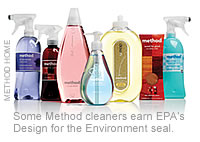
Problem: Laundry detergents, general-purpose cleaners and other products may contain nonylphenol ethoxylates, or NPEs, which can break down into a form that's toxic to aquatic life. Phosphates, found in dishwasher detergents, promote harmful algae growth. Petroleum-based cleaners, which make up a majority of the market, use up a nonrenewable resource.
Better choices: Companies don't have to reveal their secret formulas and may list slightly altered chemicals under other names. Look for cleaners that have survived tough scrutiny, such as Ipax's Green Unikleen multipurpose cleaner (www.ipax.com). Unikleen is a Green Seal-certified cleaner (www.greenseal.org), which means it's biodegradable, plus it contains no carcinogens and isn't toxic to humans or aquatic life. Green Seal has approved few consumer cleaners so far, but it will add more to the list by year's end. For cleaners free of NPEs, phosphates, chlorine and other problem chemicals, also try the Ecover (www.ecover.com), Seventh Generation (www.seventhgen.com) and BioKleen (www.biokleenhome.com) brands.
The EPA's Design for the Environment (DfE) seal has less-stringent requirements, so more products meet its standards. A chemical's effectiveness is key; if alternative products don't work as well, a risky chemical may still be used. Several products in the Method line of cleaners (www.methodhome.com) that are sold at Target stores are DfE-recognized. To qualify for the Home Depot Eco Options line, products must be DfE-recognized.
Trade-off: Most grocers, except some organic specialty markets, do not stock green-certified cleaners, and you may pay more than for conventional cleaners. But as more certified products enter the market, prices should come down.
Comments: EPA is starting a voluntary program that encourages companies to use safer alternatives to ingredients known as surfactants, such as NPEs. Some companies, such as Procter & Gamble and Unilever, have stopped using them altogether. And remember that the absence of a chemical smell doesn't mean a product can't do the job.
HOME DECORATING
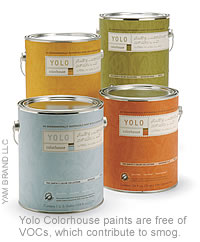
Problem: Many things in your home are made with adhesives, solvents or finishes that emit volatile organic compounds, or VOCs (the big offender in adhesives is urea formaldehyde). VOCs contribute to smog outdoors and may be highly concentrated indoors, aggravating allergies and respiratory ailments.
Better choices: Most paints and stains, including some oil-based ones, already have low VOC content, per federal standards that are becoming more stringent. VOC-free paints, such as Yolo Colorhouse paints (www.yolocolorhouse.com), cost about the same as conventional manufacturers' premium paints ($39.95 per gallon).
For cabinetry and furniture, look for products constructed with solid-wood panels or engineered wood (particleboard or medium-density fiberboard) made with low- or no-VOC finishes and water-based adhesives. Woods should come from reclaimed or sustainable sources and preferably be FSC-certified. One recommendation for cabinets is Neil Kelly Cabinets (www.neilkellycabinets.com). Ikea, which claims it is committed to the environment, uses at least some FSC woods (www.ikea.com).
Cisco Brothers (www.ciscobrothers.com) uses only FSC woods in its upholstered furniture, sold primarily through small design shops and retailers. The Q Collection (www.qcollection.com), available through interior designers, offers high-end, environmentally friendly furniture and fabrics.
Trade-offs: Residential furniture is just starting to go green, so your choices may be limited. Plus, the U.S. Department of Agriculture confers organic certification only on cotton and wool fibers, not fabric (standards are coming). Textiles made from natural fibers or dyed with natural pigments may be treated with toxic substances, such as heavy metals or fire retardants.
Comments: For an alternative to petroleum-based countertops, such as Corian, consider IceStone (www.icestone.biz; $90 to $140 per square foot). It's made from concrete and recycled glass, and you can use it for countertops, backsplashes or floor tiles. Or check out PaperStone (www.paperstoneproducts.com), made of 100% recycled, FSC-certified paper and water-based resins. Cost: $33 to $61 per square foot.
Get Kiplinger Today newsletter — free
Profit and prosper with the best of Kiplinger's advice on investing, taxes, retirement, personal finance and much more. Delivered daily. Enter your email in the box and click Sign Me Up.

-
 2026 Disney Dining Plan Returns: Free Dining for Kids & Resort Benefits
2026 Disney Dining Plan Returns: Free Dining for Kids & Resort BenefitsPlan your 2026 Walt Disney World vacation now. Learn about the returning Disney Dining Plan, how kids aged three to nine eat free, and the exclusive benefits of staying at a Disney Resort hotel.
By Carla Ayers
-
 How Can Investors Profit From AI's Energy Use?
How Can Investors Profit From AI's Energy Use?Global energy demand is expected to grow by leaps and bounds over the next several years as AI usage accelerates. Here's how to get a piece of the pie.
By Jacob Schroeder
-
 Roth IRA Contribution Limits for 2025
Roth IRA Contribution Limits for 2025Roth IRAs Roth IRA contribution limits have gone up. Here's what you need to know.
By Jackie Stewart
-
 Four Tips for Renting Out Your Home on Airbnb
Four Tips for Renting Out Your Home on Airbnbreal estate Here's what you should know before listing your home on Airbnb.
By Miriam Cross
-
 Five Ways to a Cheap Last-Minute Vacation
Five Ways to a Cheap Last-Minute VacationTravel It is possible to pull off a cheap last-minute vacation. Here are some tips to make it happen.
By Vaishali Varu
-
 How to Figure Out How Much Life Insurance You Need
How to Figure Out How Much Life Insurance You Needinsurance Instead of relying on rules of thumb, you’re better off taking a systematic approach to figuring your life insurance needs.
By Kimberly Lankford
-
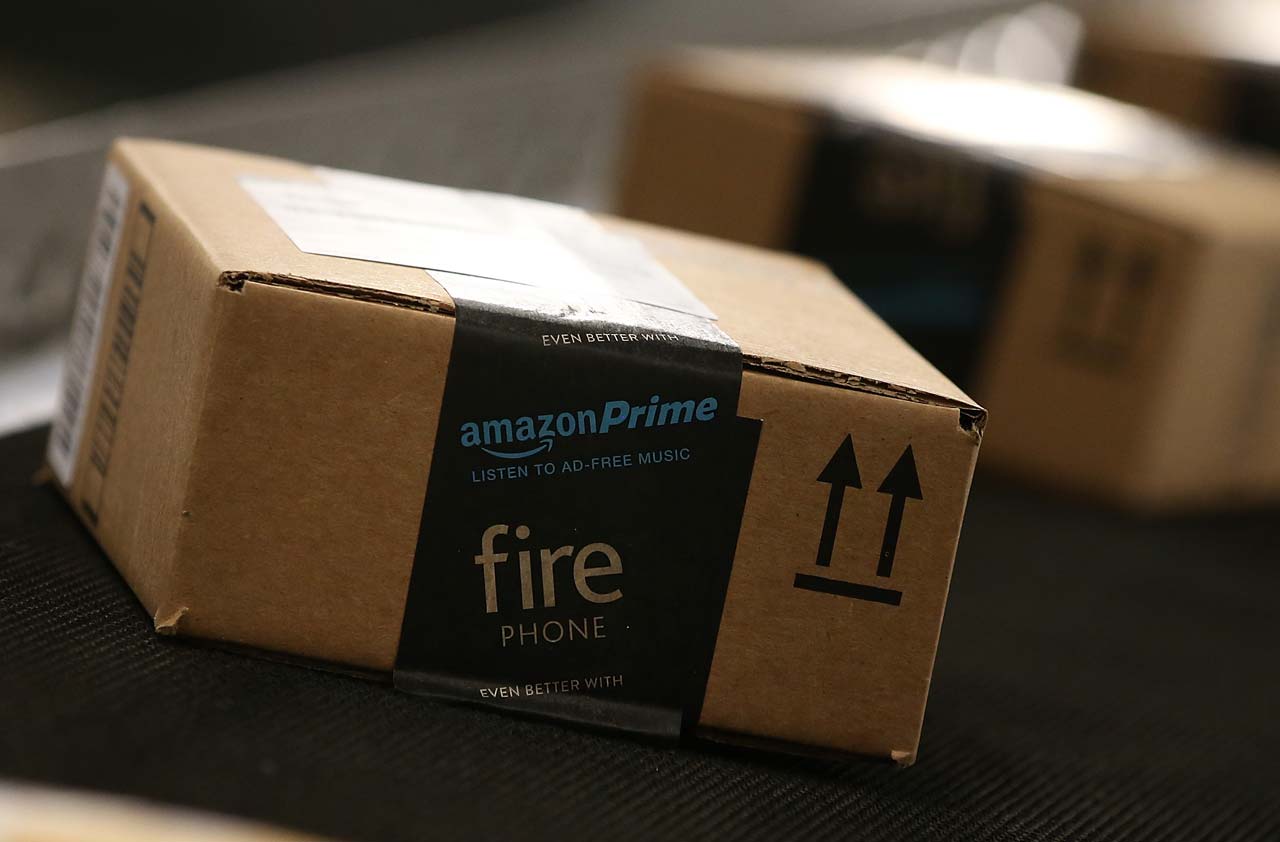 Five Reasons You Shouldn't Shop on Amazon Prime Day
Five Reasons You Shouldn't Shop on Amazon Prime DaySmart Buying Think twice before getting lured into buying a bunch of stuff you don't need just because it's on sale.
By Andrea Browne Taylor
-
 Amazon Big Deal Days Is Coming! We’ve Got All the Details
Amazon Big Deal Days Is Coming! We’ve Got All the DetailsAmazon Prime To kick off the holiday season with a bang, Amazon Big Deal Days runs Tuesday, October 8 and Wednesday, October 9.
By Bob Niedt
-
 How to Shop for Life Insurance in 3 Easy Steps
How to Shop for Life Insurance in 3 Easy Stepsinsurance Shopping for life insurance? You may be able to estimate how much you need online, but that's just the start of your search.
By Kaitlin Pitsker
-
 Five Ways to Shop for a Low Mortgage Rate
Five Ways to Shop for a Low Mortgage RateBecoming a Homeowner Mortgage rates are high this year, but you can still find an affordable loan with these tips.
By Daniel Bortz